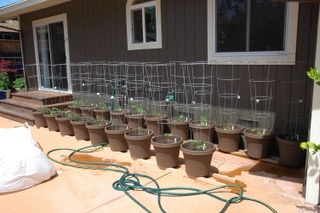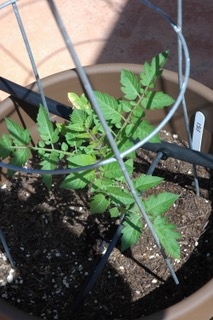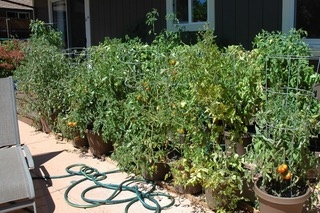With the U.C. Master Gardeners of Napa County annual Tomato Fest & Sale coming up on Saturday, April 15, and tomato plants appearing in nurseries now, it's tempting to set out your tomatoes immediately. It is best to wait a few weeks until the nights are warmer. Tomatoes thrive in daytime temperatures of 85 degrees F, and we are nowhere near that yet. Overnight temperatures should be above 50 degrees F. Keep your tomatoes inside, in a sunny window, or in a sunny greenhouse. If you ignore this advice and put them out anyway, and a cold snap is predicted, cover them with a cardboard box, or a sheet on a frame, or frost cloth.
Whether you grow your tomatoes in a container, a raised bed, or just in the ground, you should bury the stem in the soil, with just a few layers of true leaves above ground. (True leaves are the leaves with scalloped edges that appear after ten to fourteen days.) You can place the plant on a slant if needed to fit your planting situation. Don't worry, the tomato plant will straighten itself out. When you plant tomatoes deeply, the trichomes (the white fuzz on the tomato stem) will develop into roots. Those roots will spread and increase access to water and nutrients, as well as provide support for the tomato plant. However, you should put a cage over your tomato plant, because the stems will become weighed down with heavy fruit. The plant will need external support.
Soil for tomato plants should be amended with compost and fertilizer. Organic fertilizers such as chicken manure or worm compost are best. You can dig the fertilizer into the soil or top dress it. Consider companion plants for your tomatoes. Basil, borage, and nasturtium are pretty and deflect pests that might be attracted to the tomatoes. Garlic is good, too.
Tomatoes need a lot of water at first. The first two inches of soil should be damp—if the top layer of soil is dry but the lower two or three inches are moist, you can wait. When you water, don't get the leaves or tomatoes wet--water the soil only. You can also set up an irrigation system. Mulching helps keep plants from drying out.
And—tomatoes need sun. A southern exposure is best.
Last year I planted tomatoes in half barrels, with plenty of compost and chicken manure and a southern exposure against a wall and they did very well. I also planted Early Girl and Better Boy—two tomatoes that have a great success rate—in grow bags. I think the bags were too porous, and the soil dried out too quickly. Possibly the paver surface on which they were placed got too hot. Those tomatoes did not flourish.
Master Gardeners love to share advice, and I asked several of ours for tips on good tomatoes. Becky Bailey had the same problem with grow bags I had. They dried out too quickly. When she found a stray tomato plant, in desperation she planted it in a plastic sack of potting soil--she had no more bags--and it grew into a big, prolific, healthy tomato bush. She thinks the height of the sack of potting soil was a factor: “If I could find three-foot tall plastic grow bags I would be in business.”
Carolyn d'Almeida grew tomatoes in barrels along a south-facing wall. She created mini dry wells of smaller pots (with holes in the bottom) filled with gravel and set them into the barrels so that the bottom of the small pot was at the level of the tomato root zone. Filling the smaller pots with water sent the water directly where it was needed. She got plenty of tomatoes with minimal water use.
Many people had difficulties in 2022 because of the drought and extreme heat. Kathleen McClure says, “My solution? Plant fewer tomatoes and give them the water they need to survive.” She is also going to use polymer crystals, which “swell up like one inch Jell-O cubes” to hold moisture in the grow bags that she uses with great success every year.
David Layland hand waters his tomatoes and he constructed homemade irrigation rings out of terrace board, using heavy duty shears and a staple gun. They are three and four feet wide. “Not terribly scientific, but they work for me.”
Rainer Hoenicke had a persistent fungus lurking in his soil that kept his tomatoes from reaching their optimum, so he planted his in a metal horse trough with new soil. He constructed a trellis with bamboo and sisal string. He also enhanced the soil with blood meal, bone meal, and worm compost, and had excellent results.
The stellar tomato grower who outshone all the Napa Master Gardeners was the late Rich Bruhns. Not only was he a successful gardener, but he was also enthusiastic and generous with advice for those of us who struggled. Last year he told me he supplemented his soil with fish meal fertilizer, Epsom salts, ground oyster shells, and magnesium, and he said he was going to try growing tomatoes up a string, so he didn't have to use tomato cages. Rich attached a dowel at a perpendicular angle to the top of his fence, ran a cord from it to the plant, attaching the tomato stems to the string with round, loose plastic clips. The experiment worked, and Rich brought in his customary bumper crop of luscious tomatoes. He was thrilled to be done with tomato cages.
The rains have made all of us more optimistic about gardening this summer. I am looking forward to my first tomato, picked warm from the vine.
Annual Tomato Fest & Sale: This year's in-person sale will be on Saturday, April 15, from 9 am until 2 pm (or until sold out), at 1710 Soscol Avenue, cash or checks only, please. Plants are grown with care by our local UC Master Gardeners, and cost $5 each. The tomato fest features education tables staffed by our expert tomato growers. An online sale (credit cards only) follows the in-person event starting at 5 pm on April 15 until 5 pm April 16.
Food Growing Forum: April 16, 2023 3:00 pm, by zoom. We'll focus on growing tomatoes. Explore everything from planting tips, site selection, and soil prep, to tricks to growing the best-flavored tomatoes. Also learn how to avoid pests and disease and discover some tips on trellises and support. Find out what else you can plant and do now in your edible garden area as well. Event is free; sign up to get the zoom link at https://ucanr.edu/2023FoodForumAprTomatoes
Help Desk: The Master Gardener Help Desk is available to answer your garden questions on Mondays and Fridays from 10 a.m. until 1 p.m. at the University of California Cooperative Extension Office, 1710 Soscol Avenue, Suite 4, Napa. Or Send your questions to mastergardeners@countyofnapa.org. Include your name, address, phone number and a brief description of the problem. For best results, attach a photo of the plant. You may also leave a voicemail message with the same information at 707-253-4143.


